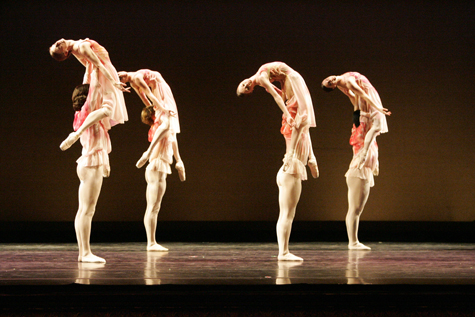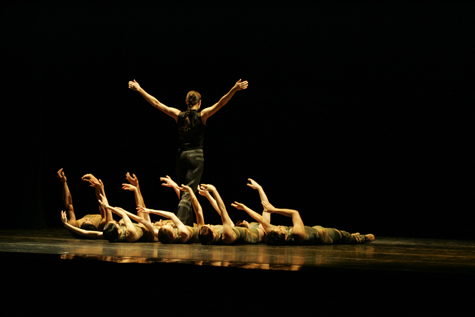
THE LEAVES ARE FADING: Antony Tudor’s piece challenged the company. |
“Masters of Motion” is the kind of catch-all title for a dance bill that encompasses everything and puts you in mind of nothing — but it would be hard to argue with the three pieces that Festival Ballet Providence presented under that rubric this past weekend: Antony Tudor’s The Leaves Are Fading (created for American Ballet Theatre in 1975), Viktor Plotnikov’s Coma (created for FBP just last year), and Agnes de Mille’s Rodeo (created for Ballet Russe de Monte Carlo in 1942). In other words, something English, something Euromodern, and something American. If you couldn’t find something you liked, you probably don’t like dance.
At the Veterans Memorial Auditorium, moreover, it was well presented enough to justify the trip from Boston (where this critic is based). The Leaves Are Fading is tea-garden Tudor, bookended by a woman (Jolanta Valeikaite at the VMA) walking about in a long filmy gown and sniffing a red rose. There are 15 dancers, six men and nine women, in rose pink and orange and white, and at first the work draws energy from the imbalance of five men partnering five women while the three remaining women try not to look like wallflowers. That isn’t Tudor’s real interest, however, and though there are some refreshing moments — two women dancing hand in hand in the absence of men; a women with a male partner who looks at the new two men who suddenly offer themselves and decides to stick with the guy she’s got; a woman who leaves her head on her guy’s shoulder while the next couple dance — they’re just way stations to the various pas de deux at the heart of The Leaves Are Fading.

In her New Yorker review of the ballet’s premiere, an essay titled “Sweet Love Remembered,” Arlene Croce (who was born in Providence) wrote that “the piece doesn’t rise to a major statement until the entrance of Gelsey Kirkland, about halfway through.” Festival Ballet Providence has some fine dancers, but no Gelsey Kirkland, and indeed this performance didn’t look like major Tudor. Croce went on to argue, “Much of the material is too difficult for dancers unused to such delicacy and intricacy.” The FBP production was staged by former ABT principal Amanda McKerrow and former ABT soloist John Gardner, and I thought the dancers — especially Leticia Guerrero (in the Gelsey Kirkland role) with Mark Harootian — were delicate and intricate enough, but the pas de deux all had the same profile and intensity. (So did the music, Dvorák’s The Cypress and other chamber music by that composer.) It was pleasing, it was pleasant, and perhaps if I had been better acquainted with the dancers, it would have seemed more. Croce’s caveat holds, all the same: can FBP go where ABT should perhaps fear to tread?

COMA: Viktor Plotnikov’s pieces challenge the audience. |
Viktor Plotnikov’s thoroughly modern dances aim to unsettle, not please. A former Boston Ballet principal who came to the US from Ukraine (his wife, Larissa Ponomarenko, still performs with Boston Ballet), Plotnikov is a choreographer to reckon with, especially in his use of props. Coma, which is set to music by Arvo Pärt, is divided into three parts: “Our Dreams”; “Reality”; “Their Dreams.” Does Robin Cook’s 1976 novel (and Michael Crichton’s 1978 film), with its organ black market, come into play here? The curtain rises on four dancers laid out on pallets suspended from the ceiling (just as at Cook’s Jefferson Institute) — call them the Coma Four. They swing back and forth. A church bell tolls; light emanates from a bank stage left. A Dark Angel (Vilia Putrius Sunday afternoon) enters, kicking and flapping, looking like the bastard bird child of Nacho Duato and Jorma Elo (with the light bank tipping it toward Elo). The Coma Four, two men and two women in brown/gray tops and pants or shorts, rise to dance, and they’re joined by the Cube Four, two men and two women in gray/brown tops and pants or long skirts, each bearing a cube closed on just one of its six sides.That’s the dialectic of “Our Dreams,” the two quartets interacting, the Dark Angel threading her way through them, and the cubes making disturbing suggestions, as when the two Cube Men lie prone with their faces inside them. At another moment the Dark Angel rides one of the men piggy-back. At the end of this movement, the beds, which had risen, descend again and the Coma Four return to stasis. “Reality” starts with a Coma Man swinging on his pallet and the Dark Angel putting a comforting hand on the shoulder of the Cube Woman who enters. An agonized duet follows before the Coma Man returns to his pallet; then the Dark Angel re-enters and the Cube Woman returns the comforting gesture. The Dark Angel stops the swinging of the pallet; the Cube Woman beats her hands against her sides. “Their Dreams” opens with the Coma Four sitting up and swinging on their pallets and the Dark Angel again threading her way through them. One by one, they rise and dance. The Cube Four come on, the women now in shorts. All eight mortals wind up on their backs, hands waving in the air. The Dark Angel freezes them in mid wave, then sits on a pallet, one leg bent, as the Coma Four were at the start of “Their Dreams.” A light bank blinds the audience. Curtain.